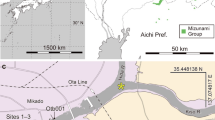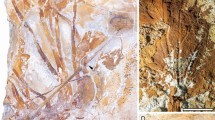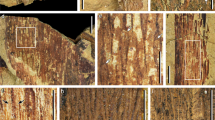Abstract
A PORTION of a slender stem, with two pedicellate flower-like structures in organic attachment, shown two-thirds natural size in Fig. 1, was recently discovered in Lower Permian beds at Vereeniging, Transvaal. Remains of Glossopteris spp. leaves and a petiole of a leaf of Noeggerathiopsis sp. occur on the same slab of red ferruginous shale. The original organic material was replaced by ferric oxide, and the plant is preserved in the form of a compressed cast of red ochre.
This is a preview of subscription content, access via your institution
Access options
Subscribe to this journal
Receive 51 print issues and online access
$199.00 per year
only $3.90 per issue
Buy this article
- Purchase on Springer Link
- Instant access to full article PDF
Prices may be subject to local taxes which are calculated during checkout
Similar content being viewed by others
References
Plumstead, Edna, P., Fourth Avanc. Stratgr. et Geol. Carbonif., 2, 548 (1962).
Author information
Authors and Affiliations
Rights and permissions
About this article
Cite this article
LE ROUX, S. A New Cycadeoid Plant from the Permo-Carboniferous Coal Measures of the Transvaal. Nature 199, 1010–1011 (1963). https://doi.org/10.1038/1991010a0
Issue Date:
DOI: https://doi.org/10.1038/1991010a0
Comments
By submitting a comment you agree to abide by our Terms and Community Guidelines. If you find something abusive or that does not comply with our terms or guidelines please flag it as inappropriate.



